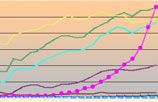What does China's growth slowdown mean to you?
By Danny Quah (Chinadaily.com.cn) Updated: 2015-03-17 16:13Suppose you're an exporting business in the US. Ten years ago US GDP was $13.1 trillion; the IMF reckons that in 2015 the US economy will produce GDP equal to $18.3 trillion. Relative to the size of the US economy, China's expected 7 percent expansion in 2015 will be an increase in a potential export market of 4.3 percent; 10 years ago, that same ratio was just 2.1 percent. Put differently, China's expansion over the next 12 months – even at only 7 percent – will represent for a typical US exporter, relative to the economy he lives in, more than a doubling of the increase in size of this potential export market.
And what if you're not in the US? If you're in the EU, China's expansion is even more of an increased opportunity. Only if you're a fast-growing economy like the ASEAN-5, does China's 7 percent growth mean something not quite so large. But even then, the worst you can say is that China's 7 percent growth means you can expect simply the same relative increase in export business with China as you did a decade ago. That's hardly a catastrophe.
(The Table below traces out a range of numbers, confirming that the positive outcome I've just described for the US and the EU continues to hold even if China went to 6 percent growth, only a little bit less so. Of course if China's growth comes in at 8 percent, the news is correspondingly better.)

But, finally, what about the capacity of China's economy to create jobs? In 2013, the latest year reported in the World Bank's World Development Indicators, China's labor force numbered 793.3 million. China's average productivity (using IMF WEO GDP numbers) was, therefore, $11,900; this had grown by 12 percent from the previous year. If productivity were to continue to grow at that same rate, then an expansion of China's GDP by $790b will generate 53 million new jobs. Since China's rural population is about 500 million (slightly less than half of its total population), if all those 53 million new jobs were urban, this would still absorb 10 percent of the rural population as migrants.
(Again, the Table below shows what would happen for variation around this scenario.)











